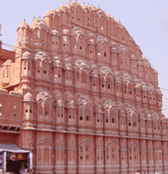 Built in 1799, by Maharaja Sawai Pratap Singh the 'Hawa Mahal', Palace
of the Wind, is one of the major landmarks of Jaipur. It is an integral
part of the City Palace, an extension of the Zenana (women's chambers)
standing away from the main complex. This five storey building of unusual
architecture designed by Lal Chand Usta, is a stunning example of Rajput
artistry made of red and pink sand stone, beautifully outlined with white
borders and motif's painted with quick lime. The monument with a spectacular
view of Jaipur city with road avenues, intersections and colourful crowds
in the market, was originally conceived with the aim of enabling ladies
of the royal household to watch the everyday life and royal processions
in the city without being seen by others.
Built in 1799, by Maharaja Sawai Pratap Singh the 'Hawa Mahal', Palace
of the Wind, is one of the major landmarks of Jaipur. It is an integral
part of the City Palace, an extension of the Zenana (women's chambers)
standing away from the main complex. This five storey building of unusual
architecture designed by Lal Chand Usta, is a stunning example of Rajput
artistry made of red and pink sand stone, beautifully outlined with white
borders and motif's painted with quick lime. The monument with a spectacular
view of Jaipur city with road avenues, intersections and colourful crowds
in the market, was originally conceived with the aim of enabling ladies
of the royal household to watch the everyday life and royal processions
in the city without being seen by others.
Its facade from the road side makes Hawa Mahal look more
like a delicate screen than a palace. This five-story, pyramid-shaped
structure has tier after tier of 953 small casements, each with tiny lattice
worked (Jali) pink windows, small balconies and arched roofs with hanging
cornices, exquisitely modeled and carved. These small windows circulate
cool air (Hawa) even in hot months. The pyramidal outline is even throughout
by cramming and multiplying casements; and uses repetition of motifs to
enhance its beauty.
The entrance to Hawa Mahal is from the City Palace side,
through a stately door which opens into a spacious courtyard. The courtyard
has a double storeyed building on three sides. There is a small archeological
museum here. Only the eastern wing has three more storeys above, which
are just a single room thick. The building, standing on a high podium,
is a fifty-foot high thin shield, less than a foot in thickness, with
small intimate chambers , which give this palace its unique facade. There
are no regular stairs to reach the upper floors, but only ramps.
Hawa Mahal which is currently under the supervision
of the State archeological department provides the visitor with excellent
views of the city. The best time to view Hawa Mahal is sunrise when sunlight
through the latticed windows gives it a wonderful glow. |

